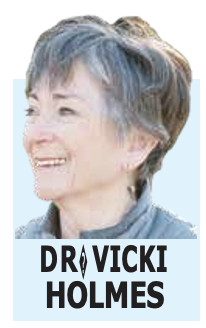
Hearing recently of several of my relatives falling, made me consider osteoporosis, and wonder if people really understand the significance of this disease.
It is called the silent thief for a reason — silently, bone structure is weakened and you may not know about it until your first fragility fracture. This is defined as a fall from standing height or less.
This is most often a fracture or the wrist, spline shoulder or hip. Sadly, although a wrist fracture can be a wakeup call that there is a much greater risk of a hip fracture, many still do not get the treatment that can prevent further fractures.
Some 2.3 million Canadians have been diagnosed with osteoporosis and many fear this is an underestimate. COVID has restricted many of our screening procedures that result in early diagnosis.
Osteoporosis is more common than heart attacks, strokes and breast cancer combined! Fragility fractures account for 80 percent of fractures in those over 50. One in three women and one in five men will experience a fracture in their lifetime. For many, a hip fracture is the tipping point that leads them to require assisted living.
Now that I have your attention, let’s discuss what you can do to get diagnosed and treated.
Everyone over 65 should have a bone density and certain risk factors suggest that you should get one if you are over 50.
- Fragility fracture after the age of 40
- Use of steroids such as prednisone
- Having a parent who fractured a hip
- Having a spine fracture or low bone mass identified on x-ray.
- Being a smoker
- Drinking three or more drinks of alcohol a day.
- Weighing less than 132 for women or a major weight loss to 10 percent less than your weight at 25
- Having other medical conditions like menopause before 45, rheumatoid arthritis, diabetes, malabsorption syndrome, hyperthyroidism.
If you have these risk factors, you will be offered a bone mineral density assessment or DEXA scan. There are two risk fracture prediction tools that are currently being used; CAROC (Canadian Association of Radiologists and Osteoporosis Canada) and FRAX.
Using your age, sex and bone mineral density at your hip, CAROC determines if you are low, moderate or high risk of fracture in the next 10 years.
Having a fragility fracture after age 40 or recent prolonged use of steroids increases you into the next highest category. Individuals with a fragility fracture of spine or hip or more than one fragility fracture are automatically in the high-risk category.
The FRAX CANADA tool guides treatment for post-menopausal women or men over 50, people with low bone density and people who have not been on treatment for osteoporosis.
You can look it up and complete it online since bone mineral density can be used, but it is not essential to give you a risk category. It asks your sex, age, height, weight, previous fracture, parental hip fracture and you can enter bone density if known.
Next comes the interesting part. Those with low risk have less than a 10 percent chance of fracturing in the next 10 years, don’t need treatment other than to get adequate exercise, and adequate calcium and vitamin D.
Those with high risk, greater than 20 percent risk of fracture definitely need treatment. Those with moderate risk, 10-19 percent, need further consideration.
They need a lateral x-ray of their thoracic spine to determine if they have a vertebral fracture or collapse of a vertebra. This is also why it is important to get ACCURATE measurement of your height when you have your checkup since losing height may be an indication of vertebral collapse.
If you have a vertebral fracture, you require treatment. If you have other risk fractures such as a prior fragility fracture, two or more falls within the last year or are on medications that can cause low bone mass, this needs evaluation.
I will admit the guidelines are a bit confusing, and there are many things to consider. Careful evaluation of drugs that can reduce bone mass, like steroids, excess thyroid replacement or hyperthyroidism.
Aromataste inhibitors used to treat breast cancer, anti-androgen therapy for men with prostate cancer, antidepressants, anti-epileptic medications, drugs for gastric reflux needs to be done and evaluate the necessity of their use.
Careful evaluation of other diseases that lead to reduced bone mass has to take place to rule out secondary osteoporosis — diseases like multiple myeloma or hyperparathyroidism, for example.
This extensive discussion is necessary to make a shared decision. A study in the US showed that only 30 percent of patients that were given a prescription actually filled it and of those initiating treatment, only half were still taking it at a year.
This is an opportunity to address risk factors that can be modified such as drinking alcohol, smoking, appropriate diet, exercise, building up muscle mass, review of medications, assessment of family history.
At this stage, you cannot turn back the clock; you need to have had adequate calcium, Vitamin D and exercise while you were young to build up bone mass, but these measures can help prevent further loss to some extent.
Be alert to these risk factors and discuss this with your doctor. This is a devastating disease that can be helped with appropriate treatment.
Dr. Vicki Holmes is a Saskatoon retired family physician who has a special interest in Palliative Care and Women’s Health. She is passionate about sharing medical information with the public! (Vicki’s Photo: Memories by Mandy)
- Dr Vicki Holmes

Leave a Reply